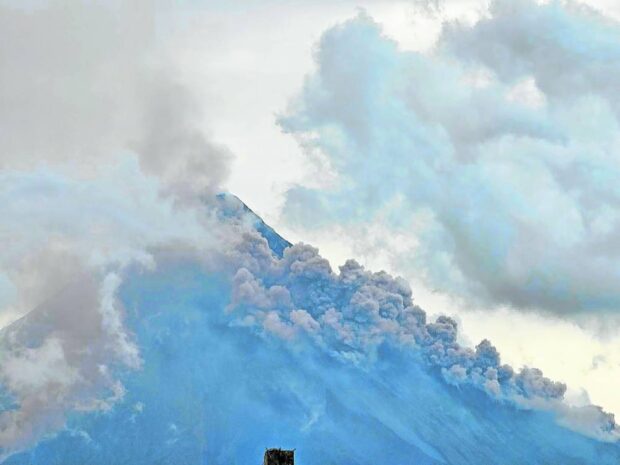
FILE PHOTO: Mayon Volcano continuously generates pyroclastic density currents and lava flow as seen in this photo taken at 5:40 p.m. on Monday, July 10, 2023, in Daraga, Albay. On July 22, the Philippine Institute of Volcanology and Seismology says Mayon Volcano had a “short-lived lava ejection” from its summit crater – a new manifestation of its unrest. (Contributed photo by DENNIS MIRABUENO)
MANILA, Philippines — The Philippine Institute of Volcanology and Seismology (Phivolcs) observed “short-lived lava ejection” from Mayon Volcano’s top crater during its latest 24-hour monitoring.
Phivolcs Science Research Specialist James Nobora told INQUIRER.net that this is a new manifestation of the volcano’s unrest.
He also confirmed that this is the first time that Phivolcs saw a brief lava ejection from Mayon since the volcano was placed under Alert Level 3 on June 8.
‘Spurting’
“Yung short-lived lava ejection ay na-observe yesterday at around 7:56 p.m. Ang event po na ‘yun, in [Filipino], ay ang pag tilamsik ng lava sa summit,” Nobora explained in a phone interview Saturday.
(The short-lived lava ejection was observed yesterday at around 7:56 p.m. That event is called spurting of lava at the summit.)
In a bulletin issued on Saturday morning, state volcanologists said they continue to record magma flows and other indicators of Mayon’s persistent state of agitation.
From 5 a.m. on Friday (July 21) to 5 a.m. on Saturday (July 22), the slow effusion of lava from the summit crater of Mayon Volcano continued to feed and bulk up on the Mi-isi, Basud, and Bonga gullies, according to the bulletin.
“The two former lava flows have maintained distal lengths of approximately 2.8 kilometers and 600 meters from the crater, while the Bonga lava flow advanced to approximately 2.7 kilometers,” Phivolcs noted.
Previous monitoring data showed that the lava flow at Bonga gully was only 2.5 kilometers as of July 21.
Phivolcs likewise reported logging four pyroclastic density currents, 175 rockfall events, and 22 volcanic earthquakes during the last observation period. It added that as of July 21, Mayon’s sulfur dioxide emission averaged at 1,758 metric tons.
“Ganon pa rin ang activity for Mayon – the same [indicators were] observed [like] the continuation of lava flow [and] occurrences ng rockfall and pyroclastic density currents. It has yet to be seen kung mag e-escalate ang activity ni Mayon Volcano pero at present, ang parameters po indicate na ongoing pa rin ang magmatic unrest niya through slow effusive activities,” Nobora concluded.
(The activity for Mayon is still the same – the same [indicators were] observed [like] the continuation of lava flow [and] occurrences of rockfall and pyroclastic density currents. It has yet to be seen if the activity of Mayon Volcano will escalate but at present, the parameters indicate that its magmatic unrest is still ongoing through slow effusive activities.)
RELATED STORIES
Albay folk brace anew for Mayon’s lahar flow
Mayon’s quake count climbs to 304, with rockfalls dropping to 137 – Phivolcs